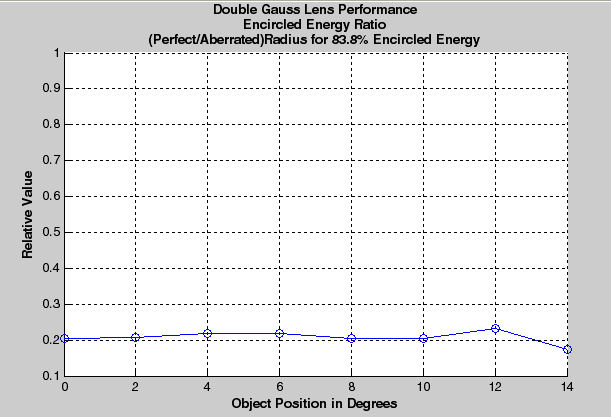Image Point Formation
For A Double Gauss Lens
 |
Double Gauss Photographic Lens
f/3.0, Object Field of View = 28 degrees, Wavelength = 0.5876 microns (green)
There are 27 objects in this simulation that are very far to the left of the lens. They are positioned on a straight line at infinity from minus fourteen degrees to plus fourteen degrees in one degree increments. We'd like this optic to form 27 perfect point images to the right of the lens in a straight line on the flat plane of our sensor.
I've selected 9 rays from from each object and traced them through the lens so you can see how they bend and attempt to focus at the image plane. The right half panel displays close-ups of those 27 imaged points, cropped by rectangles 19.8 microns on a side. (A micron is 1/1000th of a millimeter.) This rectangle does not represent the image sensor which is about 49.2 mm in size (or 49,200 microns.) What we'd like to see is the Airy disk for each image point which stays located at the same position, not wandering around inside the rectangle. A perfect image point would have a central lobe of energy about 8 times higher than what you see for the image at 0 degrees with a diameter of only 2.135 microns. That is clearly not happening for our double Gauss lens. The further you get away from the center of the image, the distinct, central peak collapses and spreads out into a spread of lumps. This is why you can conclude this lens is not very sharp.
And even this display is only part of the story. The image points here are for only one color or wavelength. Each separate wavelength from blue to red has its own distinct sets of points--some much worse than this.
Double Gauss Lens Performance
Using Encircled Energy Metric
 |
f/3.0, Object Field of View = 28 Degrees, Wavelengths: Polychromatic
And a final note. The data in this chart is derived from a mathematical analysis of an optimized design that resides in the computer. In practice, you can expect any lens performance to be worse than this because of inevitable manufacturing errors like imprecisely made surface curvatures, and lens decentration errors both axial and tangential.